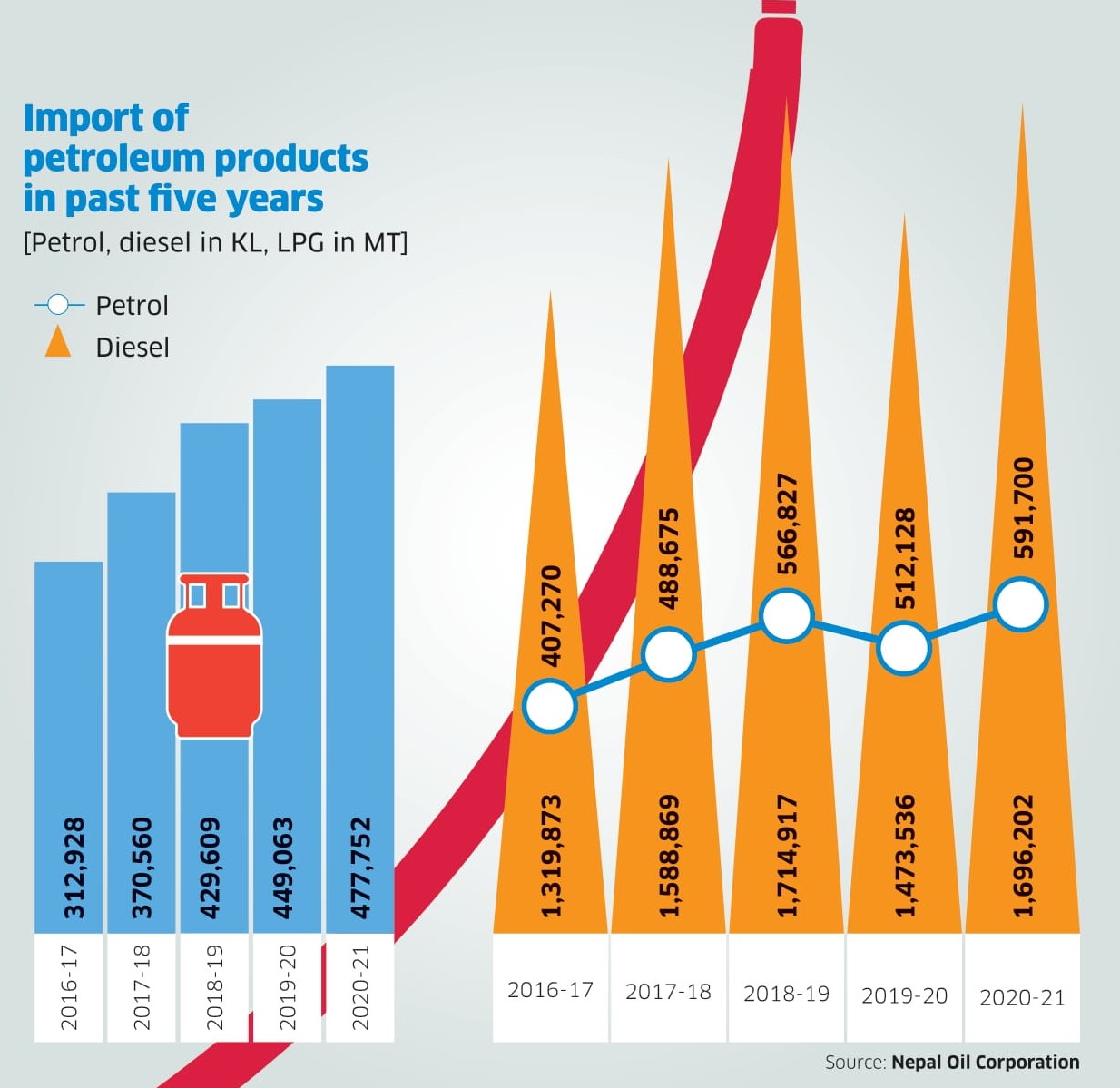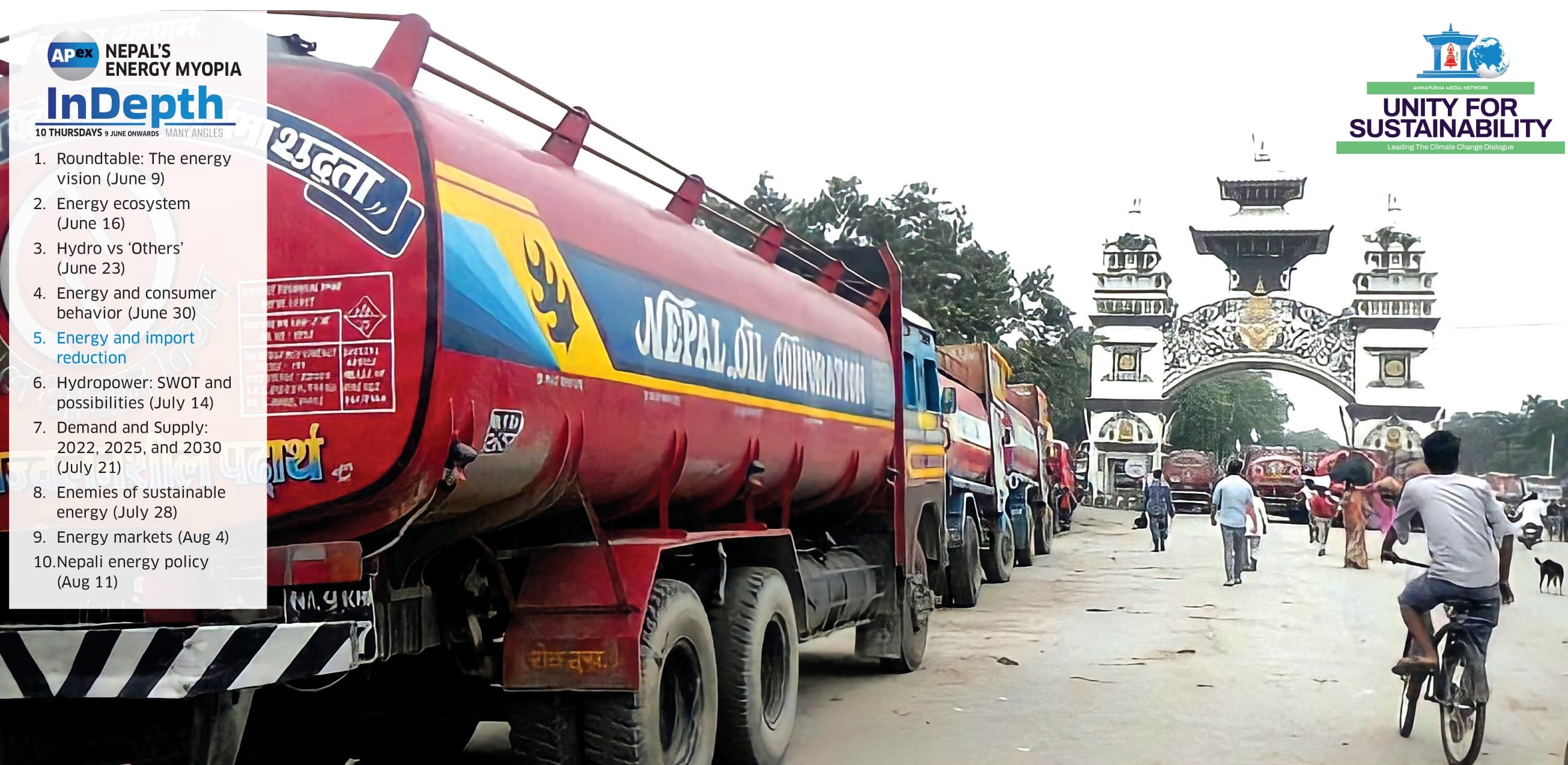Nepal urgently needs to cut down on the import of fossil fuels from India to check the rapid depletion of its foreign currency reserves and thereby forestall an economic crisis. Fuel accounts for 14.1 percent of Nepal’s imports, and reducing its import will help the country save its foreign currencies and to minimize the trade imbalance with India.
Replacing the traditional sources of energy with cleaner ones is also an imperative in order to curb the worsening air pollution and combat climate change.
On paper, import reduction is a major government priority but in practice, it is just the opposite. Our import continues to balloon by the day due to poor implementation of policies.
Nepal’s import-reliant economy is unsustainable, particularly when oil prices are skyrocketing and global supply chains have been disrupted by the Russia-Ukraine war.
Government figures suggest significant import reduction is unlikely in the near future. According to the Economic Survey published by the Ministry of Finance (2020-2021), among the petroleum products, diesel is our chief import. In the fiscal year 2019/20, diesel made for 57 percent of the import-volume followed by petrol at 20 percent, and LPG at 17 percent. Likewise, aviation fuel made for five percent of the mix while kerosene made for a percent.
Meanwhile, the import of LPG is also increasing as gas stoves rapidly displace biomass and other traditional sources in rural kitchens. According to Nepal Oil Corporation, in the past two decades, LPG imports have jumped by 2,466 percent.
It is not just fossil fuels Nepal imports from India but also half of the total electricity it consumes during the dry season (the country also exports its surplus energy to India during summer).
Nepal currently produces 2,200MW of hydro-electricity, and plans on ramping up production to 10,000MW over the next decade. But during the dry season, our hydropower stations generate only a third of the 2,200 MW while the peak demand is around 1,700 MW. Nepal then has to import around 800 MW from India.
“With some hydropower projects close to competition, there is a hope that Nepal can stop importing electricity even in the dry season. But this could take three to four years,” says Sushil Pokhrel, a hydropower expert and the managing director of Hydro Village Pvt Ltd, a consulting company.
According to Energy Minister Pampha Bhusal, 94 percent of Nepali people have access to electricity but our per capita electricity consumption is just around 300 units a year, which is the lowest in South Asia.
Bhushal is hopeful that Nepal can produce an additional 1,000 MW of electricity within the next couple of years.
Producing more electricity is one thing. But will the produced power be optimally used? And can it replace fossil fuels, so that we can reduce our import of petroleum products?
Energy experts say extreme situations demand extreme measures.
First, they say, the government should promote the use of electric vehicles (EVs) to use up all the surplus hydroelectricity. They advise all local governments to take such measures.
The number of private electric cars is increasing, which is a good start. Greater use of EVs in public offices would be a good second step.

In its policy document, the Energy Ministry says 25 percent of all private passenger vehicle sales, including two-wheelers, will be electric by 2025. It also aims to push the number of four-wheel public vehicles (besides electric rickshaws and tempos) to 20 percent.
If this target is achieved, it would decrease Nepal’s fossil fuel imports by 9 percent, a study by the ministry shows.
Experts also suggest adopting electric stoves in our kitchens. These stoves are 60 percent cheaper to buy and operate than LPG ones.
Environmentalist Bhushan Tuladhar advises launching a special campaign to motivate people to switch to electric stoves.
“Instead of exporting electricity to India, we must utilize it in cooking. Around 67 percent of Nepalis still use the smoky biomass to cook. We need to launch a special campaign to switch to clean energy in our kitchens,” he says.
Tuladhar believes local governments have a big role to play in such campaigns.
Nepal has so far earned $25m from carbon trade and this income has been invested in alternative energy. Nepal’s Nationally Determined Contribution (NDC) submitted at the United Nations pledges the use of electric stoves as their primary mode of cooking by 25 percent Nepali households by 2030. Similarly, it aims to install 500,000 improved cooking stoves in rural areas by 2025, besides also adding 200,000 household biogas plants and 500 large-scale biogas plants.
There are challenges to transitioning into electric cooking though, such as erratic electricity supply and lack of incentives for those who want to switch.
Pokhrel, of Hydro Village, says oversupply of electricity is damaging transformers and wires in some places, discouraging people from using more of it. Then there is the issue of power cuts.
“People have taken to LGP for cooking purposes as it can be stored and used as and when needed. In the case of electricity, there is no way to ensure its round-the-clock availability,” he says.
Nepal also imports some coal from India, but the exact data is not available.
Deepak Gyawali, former water resource minister, says coal can be produced even in Nepal and there is no need to import it.
“There are legal hurdles to producing commercial coal. But if we can somehow legalize coal production, we can reduce our import bill,” he says.
To cut the consumption of petroleum products, the former minister also suggests a ropeway system for goods transport.
“Right now we are using a transport system that is heavily reliant on petrol and diesel. But we can easily install ropeways and operate them with locally produced electricity,” he adds.
Wind is another source of clean energy but there hasn’t been much study on it in Nepal. Some energy experts reckon Nepal cannot produce enough wind energy to make a significant dent on our fuel import.
There is a hope for solar energy though. The Alternative Energy Promotion Center is taking various initiatives to promote solar and other alternative energy sources.
Nepal right now generates 34 MW electricity from small and micro hydropower projects and 38 MW from solar and wind sources.
Solar could be an alternative in geographically challenged areas where it is difficult to build transmission lines.
Nepal also has international climate obligations to meet as well. The country aims to reach net-zero emissions by 2045 and to this end, it has pledged to cover 15 percent of the total energy demand through clean energy sources.
To achieve this target, drastic and immediate measures are needed to promote homegrown clean energy.
“We cannot completely displace fossil fuels as there are certain areas where we have to continue to use them. But we can substantially decrease their consumption with the right policies and their strict implementation,” says Gyawali, the former water resources minister.












